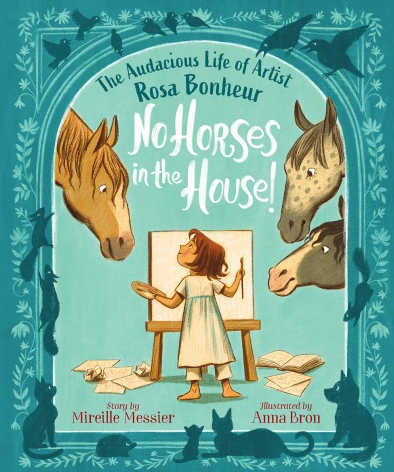No Horses in the House! The Audacious Life of Artist Rosa Bonheur

No Horses in the House! The Audacious Life of Artist Rosa Bonheur
But the family’s neighbours and friends didn’t approve of how Rosa was spending her days.
They frowned and said, “You can’t be an artist!”
“Why not?” Rosa asked.
“Because you are a girl.”
Rosa did not agree - she would be an artist.
The first girl to be an artist on her street…in her arrondissement…in all of Paris even. And she would be the best one they had ever seen.
In France in 1829, a young girl named Rosa Bonheur loved to draw animals. She loved to draw all sorts of animals, such as cats, goats, cows, and rabbits. But she loved to draw horses the most. However, at that time, girls were not allowed to be artists. She was sent to school to learn how to read, sew, and cook, but Rosa did not have any interest in such things, and so she did not do very well in school. After many attempts to teach her other things, Rosa’s father finally agreed to teach her how to draw. The neighbours disapproved of Rosa drawing, believing that girls were not allowed to draw, but Rosa was determined to be the best artist in all of Paris. She practiced every day, closely studying the fur, muscles, and distinct features of each animal that she drew.
One day, Rosa discovered the horse market where she found different breeds of horses she had never seen before. She was absolutely fascinated, but the men of the horse market kicked her out because she was a girl. While staying at home, Rosa brought home animals to study. Her house was soon filled with pigs, goats, and cats. But her father put his foot down and did not allow Rosa to bring home a horse. Instead, Rosa tried to dress as a boy and sneak into the horse market, but the authorities saw through her disguise. They said it was against the law for her to dress as a boy, and so Rosa fought to get a special permit from the government saying she could dress as she pleased.
Eventually, Rosa exhibited her large, lifelike paintings at the Salon de Paris. Many people loved her work, but others still did not take her seriously. Rosa charged on, painting bigger and better art pieces. Eventually, kings and queens from all over the world came to see her beautiful paintings. Rosa achieved her dream and became a famous artist in France.
With beautifully drawn illustrations by Anna Bron, Mireille Messier’s text creates a wonderful depiction of Rosa Bonheur’s early life and her struggle to fame. Although the story has been fictitionalized, readers can still get the sense that Rosa was stubborn and determined to follow her dream to become an artist. She worked hard and practiced her skills daily, overcoming societal disapproval and numerous attempts to stop her. No Horses in the House! is a story of female empowerment and persistence.
Additionally, Messier offers opportunities to introduce readers to some French vocabulary, words such as arrondissement (borough) and balivernes (nonsense). At the end of the book, there is a comprehensive information graphic that marks important dates and milestones of Rosa’s life, including when she met her life-long partner, Nathalie Micas, also uncommon in French society at the time.
Caregivers and teachers reading No Horses in the House! with younger children will appreciate the opportunity to discuss the historical significance of Rosa’s life and work, and how children today can benefit from her example and achievements. For those readers who love to draw and express their own creativity, No Horses in the House! is a fun and wonderful book of courage and endurance against the odds.
Julia Pitre is a Children’s Librarian in London, Ontario.
